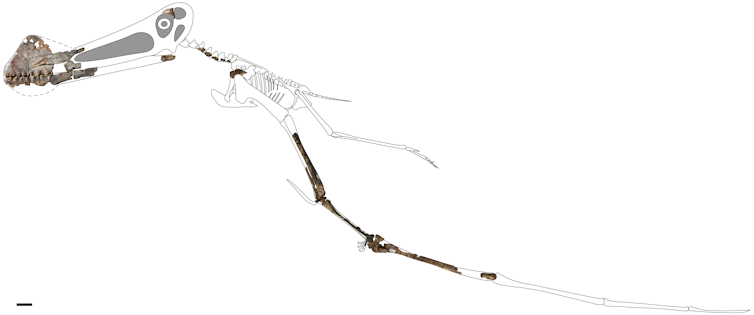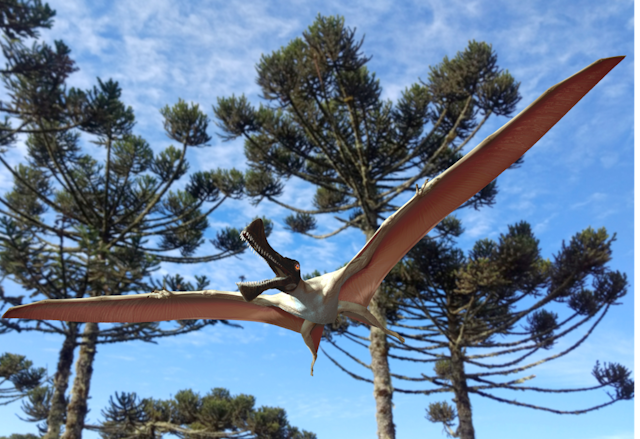The most significant pterosaur fossil ever discovered in Australia has been unearthed in the Winton area of central western Queensland.
The newly discovered species, which my colleagues and I have named Ferrodraco lentoni, had a wingspan of about 4 metres. It lived around 96 million years ago, and was surprisingly similar to other pterosaurs from England, suggesting that these huge flying reptiles could traverse the globe with relative ease.
Pterosaurs are quite rare in the fossil record, as their bones are hollow and the outer bone in most instances is only 1mm thick. Only 15 pterosaur specimens have ever been scientifically described from Australia, many of them incomplete.
Until recently, only two species of Australian pterosaur had been described: Mythunga camara and Aussiedraco molnari, both based on fossil skull fragments.
Although more complete fossils of similar pterosaurs are known from Brazil and China, until this discovery, our understanding of the pterosaurs that lived in Australia during the Cretaceous period was limited.
Read more: Hundreds of pterosaur eggs help reveal the early life of flying reptiles
The new pterosaur specimen, unveiled today in the journal Scientific Reports, includes a partial skull, five partial neck vertebrae, and bones from both the left and right wings.

This particular individual represents a fully grown adult, based on the fusion seen in several bones. Judging by its wing bones and the dimensions of similar pterosaurs, Ferrodraco would have had a wingspan of about 4 metres, with a skull probably reaching 60cm in length. It is likely that it ate mainly fish.
The genus name Ferrodraco refers to the fact that this winged reptile was found preserved in ironstone. And the species name lentoni honours former Winton Shire mayor Graham “Butch” Lenton, in recognition of his service to the community. The Winton area has within recent decades produced several well-preserved dinosaur fossils.
Ferrodraco lived 96 million years ago, around lake and river systems surrounded by conifer forests. Based on other fossil evidence, this pterosaur shared its environment with several dinosaurs including the sauropods Diamantinasaurus and Savannasaurus, theropods such as Australovenator, ornithopods and ankylosaurs. Competing with Ferrodraco for fish in the freshwater river systems were crocodylomorphs (such as Isisfordia) and plesiosaurs.
Game-changer
The Ferrodraco specimen was discovered by Winton grazier Bob Elliott in April 2017 when he was spraying weedkiller along the banks of a creek on Belmont Station. It’s not the first major fossil find on Belmont Station – the unique sauropod dinosaur Savannasaurus elliottorum was discovered just 10km from the pterosaur site.
Unlike other fossil sites in the Winton area, the pterosaur remains were found in the banks of a creek and had likely been exposed to the elements for several years. One bone from the wing had even been kicked away from the main site by livestock travelling through the creek. Had the bones not been infiltrated by iron-rich fluids, which ultimately became ironstone, these precious fossils would have been lost to erosion many years ago.
Unlike many other fossils, the bones were covered by a thin layer of rock. This meant that Ferrodraco had an unusually quick journey (by palaeontological standards) from discovery to scientific publication.
Preparation of the specimen was finished within a week by preparator Ali Calvey. Even before the bones had been fully prepared, our team was able to make detailed observations and determine which family of pterosaurs this specimen belonged to.
Surprisingly, Ferrodraco shows closer ties with similarly aged pterosaurs from England than it does to those from South America. This suggests that these pterosaurs, collectively known as ornithocheirids, could easily fly across oceans and disperse between continents.
Read more: Pterosaurs should have been too big to fly – so how did they manage it?
This idea has been put forward by other palaeontologists, but the dearth of material from Australia had made it difficult to verify until now.
Ferrodraco has changed the game in that regard, demonstrating that it was living at least as recently as its Northern Hemisphere ornithocheirid cousins. In fact, it might represent one of the geologically youngest ornithocheirids ever found. Although more work needs to be done to demonstrate this, Ferrodraco is nevertheless one of the most important pterosaur specimens ever found in Australia.

